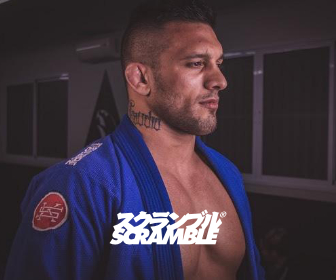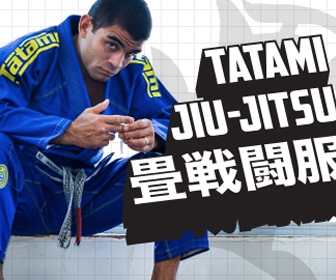Back in the Spring of 2018 (check here), we ran the data on two years worth of referee decisions at the black belt level of the IBJJF World Championships. Although with a few interesting findings, the data pool from that report was too small to outline substantial conclusions. For that reason, and as we have just kick-started the 2021 Worlds, BJJ Heroes decided to revisit this topic. This time we doubled the data supply by extracting the information from 2016, 2017, 2018, and 2019 World Championships, adding 2016 and 2019 to the previous report.
Given how elusive referee decisions can be, the intent of this study is to try and decipher what pushes referees to pick one athlete over the other when choosing the victor of a match that is even across the scoreboard.
DATA POOL
As mentioned in the first paragraph of this article, the research of this expansive topic was based on the last 4 events of the International Brazilian Jiu-Jitsu Federation (IBJJF) World Championships: 2016, 2017, 2018, and 2019. Selecting the adult black belt divisions for that effect. Over 800 clashes of which 7.2% were referee decisions.
NATIONALITY
Does it count?
In our previous 2018 report, the Brazilian hegemony stigma proved to be somewhat valid, with Brazil beating the USA by 5×2 in 7 direct clashes. That was then, this is now. With a larger sample of clashes between the two most prominent nations in our sport, we saw the tables quickly turned in America’s favor as seen in our USA vs Brazil pie chart below.
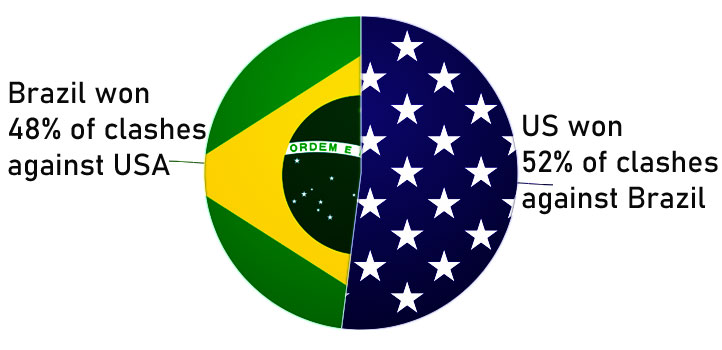
For many years we have heard the “getting gringo’ed” expression when seeing non-Brazilian athletes at the wrong end of a ref. decision, as if to express favoritism towards the South American players. Interestingly, the new data showed a much more balanced outcome, possibly putting some of that stigma to rest, at least at the highest level of the sport.
Given that most other nations only had one or two matches against either BRA or the USA, there wasn’t enough information to grant a more elaborate conclusion on the dynamics of these two dominant countries over the others.
JIU-JITSU ROYALTY
Are the sport’s biggest stars “decision proof”?
One topic we did not cover last time we addressed the issue of Decision Wins In The IBJJF was how well-established jiu-jitsu players hold up against newcomers or athletes of lower status.
Granted, status is a hard trait to pinpoint in our sport as there are a variety of ways with which to address this social condition. Many athletes who have never won a major jiu-jitsu tournament are, through keeping clever social media content or by being propped up by media outlets, vastly more famous and have wider fan bases than many IBJJF or ADCC champions. For the purpose of this study, however, and considering how hard it is to define social rank, we have opted to look at matches between IBJJF World Champions and non-champions. This meant athletes who had conquered an IBJJF black belt world title in the past versus those who had never medaled in the tournament at the black belt level.
This was THE most expressive factor in our study. The data here could not be clearer: in 23 matches observed under the conditions laid out, 82% of the wins went to the athlete who had conquered a world title prior to the event. The least recognized athlete only received the referee’s nod in very clear-cut cases such as the Patrick Gaudio versus Rômulo Barral (2017), where Gaudio broke Barral’s foot with a toe hold, but the legendary world champion refused to tap. The match ended in a draw, but there was a clear winner.
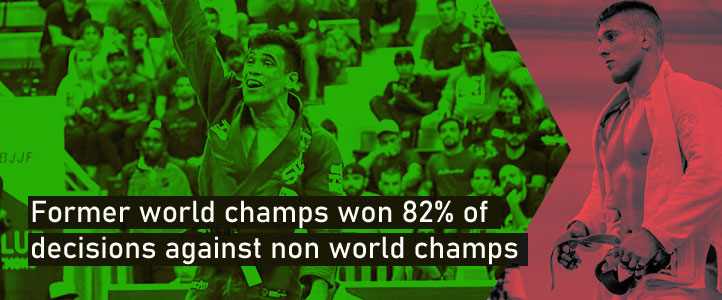
Interestingly, going on a little tangent here, Patrick Gaudio was the athlete with the most referee-decided matches across the board over the past 4 years. 6 matches overall, 4 wins, 2 losses, beating 2 former world champions in Tarsys Humphreys and Rômulo Barral. From the world champions’ side, only Rubens Charles “Cobrinha” was involved in more than one decision, winning them both.
IS THERE TEAM BIAS?
Do certain, more established, BJJ Teams Give Athletes An Advantage
A big part of jiu-jitsu culture is the team dynamics, and not unlike any other team sports, big/historic clubs do tend to carry a degree of weight on the mats. Another layer to the aforementioned status dynamics.
The weight certain team leaders hold over the rulings of the IBJJF behind the scenes is a topic often discussed among the sport’s fans and practitioners, but do these suspicion bear weight on the data? To an extent, yes. But maybe not as one would imagine.
Gracie Barra, for example, a team that has been historically linked with the federation (as it once shared its leadership with the IBJJF’s) does not fare well in bouts decided by the referees, winning only 37.5% of matches there. In that regard, however, none of the big teams had it worst than Checkmat.
The team led by the Vieria Brothers, Leonardo, and Ricardo, conquered only 27% of the referee decisions it participated in, losing a whopping 73% of those clashes. An abysmal difference from the other top jiu-jitsu academies. When looking for any particular trend across all 15 Checkmat matches decided by the judges, individually, we could not find any pattern worthy of reference. Meaning, the only common denominator in these matches was that the loser was from Checkmat.
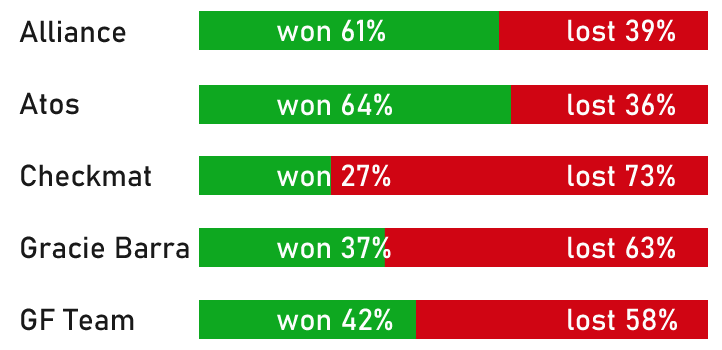
If there is a bias to report here, that would appear to be going towards Alliance and Atos. The past 10 editions of the IBJJF World Championships have been won by either of these two teams, the most dominant workgroups in the sport. Coincidence or not, these were the only academies with an over 60% decision winning rate.
Although statistically not as strong as the data shown in the “Jiu-Jitsu Royalty” section of this study, the Team “Bias” here presented is still significant. These Indicators are also somewhat predicated by the fact that many of the athletes from these two teams’ are also former world champions. In the case of Atos, 42% of decision wins recorded were won by former gold medalists, while Alliance saw 46% of its decisions won by their own world champs.
TOP OR BOTTOM
Who has the upper hand, guard players or guard passers?
Is a guard player at a disadvantage or an advantage in the eyes of the referees? In the old days of jiu-jitsu, the guard was often commented as “The Best Of Worst Positions”, but those were the old days when the sporting context was not as prominent as it is today. In the era of double guard-pulling, is being on the bottom a disadvantage from a judging standpoint?
The data here is conclusive in showing the irrelevance of this type of positional hierarchy in modern-day grappling. When accounting for the total amount of minutes spent on the top position, between winners and losers, we see a 52% time spent on top by the winners’ group and 48% spent on top by the losers.
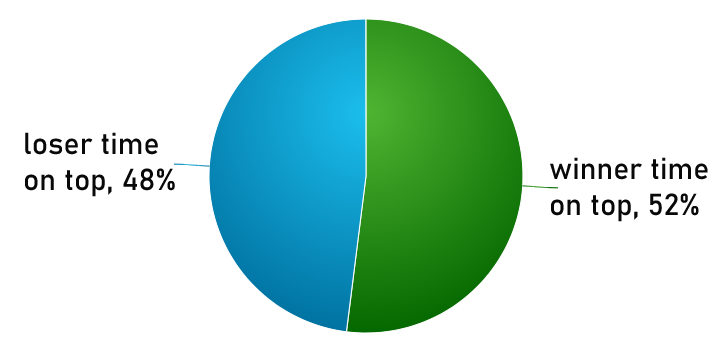
– 17 guard pullers won the match (53%)
– 15 guard pullers lost the match (47%)
Guard pulling can be another contentious topic. Do we consider guard pulling to be a concession (conceding the top control) or is it the action of someone trying to initiate the fight first (pushing the pace)? Again, the data here is nearly 50-50 and appears to have little to no influence in deciding the victor.
What about ending the match on top, is there any statistical significance to it? Once again, the battle of top or bottom hierarchy bore no significant results. 52% of athletes who ended the match on top lost the referee decision, 48% won.
ACTION, WHO PUSHES THE PACE?
When it comes to pushing the pace the IBJJF differs greatly in its understanding of these dynamics from other federations such as the AJP. With the Abu Dhabi based organization, whoever scores last, wins the match. Here, at the IBJJF World Championships, there was almost no added value to scoring last with the results showing a mere 54% win ratio to the enforcer of the final scoreboard points when the match goes to a decision.
With regards to submission attempts, this is also not a clear path towards victory as only 58% of athletes who hunted for and got seemingly close to a submission ended up winning the match. One of the stronger cases for winning the decision race seems to be the hunt for the guard pass as nearly 70% of athletes who initiated passes ended up winning the match. Below is a list of which attempted maneuvers correlated best a hand raise by the IBJJF referees:
– Most Submission Attempts won 58% of matches
– Most Passing Attempts Won 68% of matches
– Most Sweeping Attempts Won: 68% of matches
– Most Takedown Attempts Won: 85% of matches
In even matches, as expected, the athlete who attempted to score the most will increase his chances of victory. Competitors with the most overall offensive attempts (from our own understanding) generated 68% of hands raised.
FINAL NOTES
There is a reason why so many jiu-jitsu commentators say, at the end of a tied match “I wouldn’t want to be the one making a decision here”. Deciding who wins a match is a hard task. One with a lot of room left for interpretation.
Among all the many variables possible, it seems as though THE deciding factor is an athlete’s competitive status. As mentioned above, the most definitive stat on this study was how former world champions conquered the vast majority of the decisions regardless of all other factors (guard pulling or not, takedown attempts or not, guard passes or not, etc).






